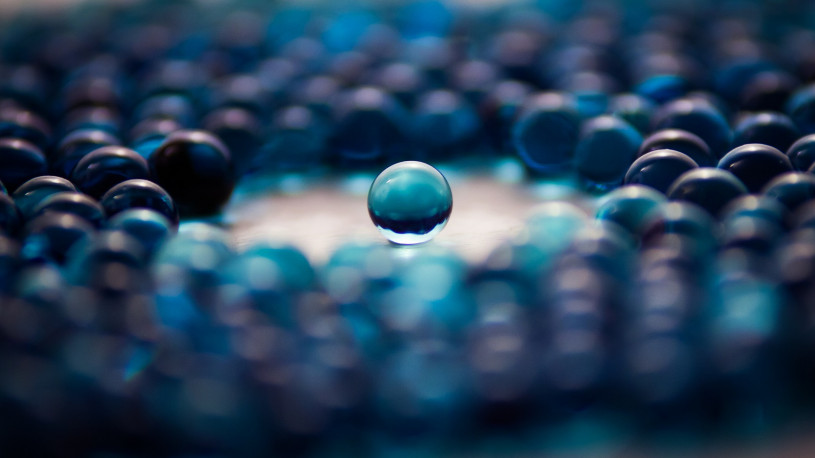-
The Growing Use and Market for Microspheres
 Continue Reading
Continue ReadingToday’s material science is growing at a hyperbolic rate. It seems that every day a ground breaking new substance is being discovered, be it graphene, biological nylon, breathable polyethylene textiles, or biodegradable polymers. But sometimes, older technologies come to the fore as the world finds greater uses for forgotten technology.
One such product is microspheres, a decades old invention that up until today had a set number of uses. But as scientists continue to push the boundaries of chemical engineering, they are finding more and more uses for these tiny balls. It seems that the microsphere industry might be about to really take off.
For example, microspheres have recently been developed as a raw material for the manufacture of cheaper, brighter greenhouses, with global manufacturer 3M recently announcing, that it will add glass microspheres to the polymer films it makes for greenhouses for the agricultural industry.
The reason for this is clear, as industry journal Plastic News, explains, “Using microspheres can allow producers to make more amounts of low density and linear low density film with the same amount of resin.”
Furthermore, adds Fernando Cervantes, Application Development Engineer at 3M, “Microspheres also can provide whiteness to films, allowing for the replacement of titanium dioxide. The materials also can spread light over a greater area, which helps plant growth.”
Whilst the use of microspheres in growing houses will not change the chemical industry, it is a sign of a small revolution taking place. Microspheres are having a larger and more diverse role in modern manufacturing, than ever before. They are being seen as a well-priced and versatile feedstock with all manner of uses. In making lighter car parts for the automobile industry, in being used as to repair weak bones in the pharmaceutical industry, in improving the sealant effect of corks, or in making greenhouses brighter and cheaper, microspheres are showing that they are an industrial raw material to be considered.
Moreover, as more products become dependent on microspheres and as global standards of living rise, possibly the only concern for the market is whether microsphere supply can keep up with microsphere demand.
Photo credit: Apex greenshouses
-
What can the Chemical Industry Learn from an Unbreakable Watermelon?
 Continue Reading
Continue ReadingThe Internet is full of weird and wonderful videos, but alongside a 415ft basketball shot and the world record 543,210 domino topple, is the sight of a watermelon hitting the tarmac after a 43m (148ft) fall without breaking.
Thanks to a polymer coating called LINE-X, the watermelon simply bounced. The test team then failed to break open the melon with an axe, before finally cracking the fruit open with an angle grinder.
With over 800,000 views in less than a week, you can see the strange power of polymer coatings on YouTube here.
While the Internet is raging about this new discovery, it is taking wiser minds inside the polymer and coating industries to highlight the fact that the protective spray has been on the market for over a decade. So the question is; why isn’t the chemical industry doing more to promote the amazing science and material advances that it is making?
With Polymer Coatings like this; Why Wait for YouTube Watermelons?
Some pop-science YouTubers are making headway. For example, the YouTube channel Veritasium has almost 4 million subscribers. Its host, Derek Muller, is no fool for science, having earned his PhD from the University of Sydney, and he uses his knowledge to good effect, by adding science to the fun, or maybe fun to the science. Either way, his latest clip gives some explanation to the fascination of the unbreakable watermelon, describing the coating as, a mix of, “Diphenylmethane-4,4’-diisocyanate (or MDI for short) and a plasticizer, namely alpha-(2-aminomethylethyl)-omega-(2-aminomethylethoxy)-poly(oxy(methyl-1,2-ethanediyl)); a long name for a long chain molecule, which in reality would have an even longer name than this.”
Another popular science website is called Futurism. Its covers many different fields, but its Industrial Rev 2.0 page is highly recommended, focusing as it does on real world applications for material science. For example, on the watermelon polymer coating story, it adds that, “Tests conducted by the Air Force Research Laboratory (AFRL) and U.S. Army Corps. of Engineers (USACE) in 2006 showed that LINE-X-protected buildings could withstand up to 1,100 pounds of explosives. The inner walls of the Pentagon are already lined with the material to help it withstand attacks from terrorists or other threats, but civilian structures of the future could potentially use it to help combat the effects of natural disasters like hurricane or earthquakes.”
Interesting, real world information on modern industrial chemical applications with a positive impact; now there’s a thought!
Instead, so much news on chemical products refers to the potential damage they may or may not cause. Such as the website of the Environmental Working Group, that argues of the health risks of the watermelon coating’s perfluorochemicals.
Possibly any chemical product named alpha-(2-aminomethylethyl)-omega-(2-aminomethylethoxy)-poly(oxy(methyl-1,2-ethanediyl)) will cause issues.
Maybe this is the heart of the problem. For 500 years, the scientific world has attempted to keep its industry elitist, with its use of Latin and its closed communities, such as the Royal Academy.
Should the Modern Chemical Industry be More ‘Out There’ with What it can Do?
Chemical industry insiders already know what a $3 trillion industry can achieve. It is an industry that helped build drivable 3D printed cars, helped put mankind into space and can save the world from climate change. So surely swaying public opinion would be easy. After all, the beverage industry persuaded as to pay for bottled water.
The Wall Street Journal reported last year of the cuts that some of the larger multi-nationals chemical companies were making in their advertising budgets. Stating that, “Procter & Gamble Co. is preparing to make deep cuts in the number of advertising agencies it works with, hoping to save up to half-a-billion dollars in [advertising] fees. [While] Unilever, which spent roughly $7 billion on advertising and marketing last year, is currently reviewing its global media-buying business.”
If a chemical supplier has $7 billion to spend on helping consumers choose a brand that is likely similar to other brands, then think how effective it could be at broadcasting a positive message about the chemical industry with all the good that it does.
Now that we are in the age of the Internet, isn’t it time we that began to invest more in dismantling the fear around chemistry and the chemical industry? After all, it didn’t take more than a sack full of watermelon’s to show the power of the polymer coating industry.
Photo credit: nerdist.com
-
The EU’s “Winter Package” Energy Policy and the Biofuel and the Chemicals Industry
 Continue Reading
Continue ReadingWith low-energy fanfare, the European Commission has released its ‘winter package’, a document that outlines its energy policy for the coming years. The proposed legislation is a bold and far-reaching swathe of laws that will form the bedrock of the EU’s efforts to meet Paris COP21 climate change targets.
However, many have been left disappointed by the move, complaining that the plans were released before consulting industry heads, that the focus on switching to renewable energy sources doesn’t go far enough, or that in trying write an energy policy for all of Europe’s diverse economies and industries, the legislation pleases no one.
Certainly the proposals are grand. As the Guardian reports, “In total, eight pieces of legislation were proposed today [30/11/2016], covering a dizzying array of issues from electricity market design to energy poverty, and from biofuels to security of supply.” So it is no wonder if some of the laws miss their targets, or if some noses are put out of joint.
The Guardian continues by noting how a number of environmental groups that see the winter package as a missed opportunity. Reporting how, “Jonathan Gaventa of E3G called the legislation ‘politically cautious’ while ClientEarth lawyer Maria Kleis-Walravens dubbed it ‘disappointing in the extreme’. [Whereas] Sini Eräjää, a spokeswoman for BirdLife Europe, said: ‘Ignoring science and brushing aside evidence of the destructive impacts of current use will not make these problems go away. It will more likely make them worse.’”
Cefic, The European Chemical Industry Council, however, has been generally positive about the proposals. Stating that, “This package represents a business opportunity for chemical companies. The Energy Performance of Buildings Directive, Energy Efficiency and Renewable Energy Directive will generate business opportunities for the European chemical industry. We manufacture products for energy savings, solar cells and windmills, insulation and lighter cars. The construction industry is the chemical industry’s second biggest customer, amounting to 8% of total chemical demand. Cefic stresses the importance of the circular economy of CO2 through the integration of carbon capture and utilisation (CCU) as an option for the future.”
Although the agency is critical of what it sees as some policy flip-flopping, stating that, “While many elements of the package are well designed, others are not – jumping from supporting renewables to supporting capacity payments being one case.”
It has also been noted by others that, “The [EU] bloc has pledged to phase out subsidies for food-based energy crops, but the revised renewable energy directive released only whittles down a cap on such biofuels from 7% in 2020 to 3.8% in 2030.” Bringing into question exactly what direction Brussels is heading on the matter.
Others argue that synthetic fossil fuels should be removed from the EU’s way of thinking. For example, Bellona [an independent, environmental NGO] simply states that, “Synthetic fossil fuels are not renewable, nor sustainable, economically or in any other way. Capturing CO2 from industrial facilities and preventing it from entering the atmosphere is, indeed, a major step in decarbonising industry. However, using that CO2 to make synthetic fossil fuels, after which the CO2 is deposited in the atmosphere during fuel combustion, is costly, energy-demanding, and does not make sense from a climate perspective.” Leading them to “urge” that, “synthetic fuels, produced with waste-stream industrial CO2, be left out of the Renewable Energy Directive.”
Perhaps the diplomats are overreacting. After all, while Bellona is right to state that, “this [winter] package forms the Commission’s official position vis-à-vis the Union’s climate and energy policy towards 2030.” It also notes that the policies are not yet legally binding and are, “still pending negotiation and approval by the European Parliament and Member States.”
So once the horse trading and special interests of national governments begin to apply further influence, it is quite possible that the ‘winter package’ will be an entirely different beast. Although the chemical industry, with its long-term investment requirements, will prefer a quicker resolution of how the continent plans to combat climate change.
It is already reeling under the expense of increasing levels of bureaucracy. The introduction of REACH, amongst other layers of red-tape, is proving costly. As ICIS highlighted in June 2016, “EU chemical regulation costs firms across the 28-country bloc €9.5bn/year, according to the long-awaited cumulative cost assessment [recently] published by the European Commission.” Adding that this, “represented around 2% of turnover and 12% of the value added.”
When combined with fluctuating oil prices, an unstable logistics market, US shale gas development, political uncertainty at home, and economic uncertainty in China, analysts are not surprised that the chemical industry is stagnating.
While the EU’s introduction of a ‘winter package’ will NOT be the end of the European chemical industry, its timing is unfortunate. Or maybe even irrelevant, for after all, when the bureaucrats have set the targets, and the caps and subsidies have been named, it is primarily consumer demand that will fire recovery.
As Cefic’s Director General, Marco Mensink, said upon reading the ‘winter package’ and what it had in store for the chemicals industry; “It is markets, not targets that will drive change.” Something which chemical traders, plastics manufacturers, agrichemical product developers, and anyone else who works in the chemicals industry would do well to remember.
